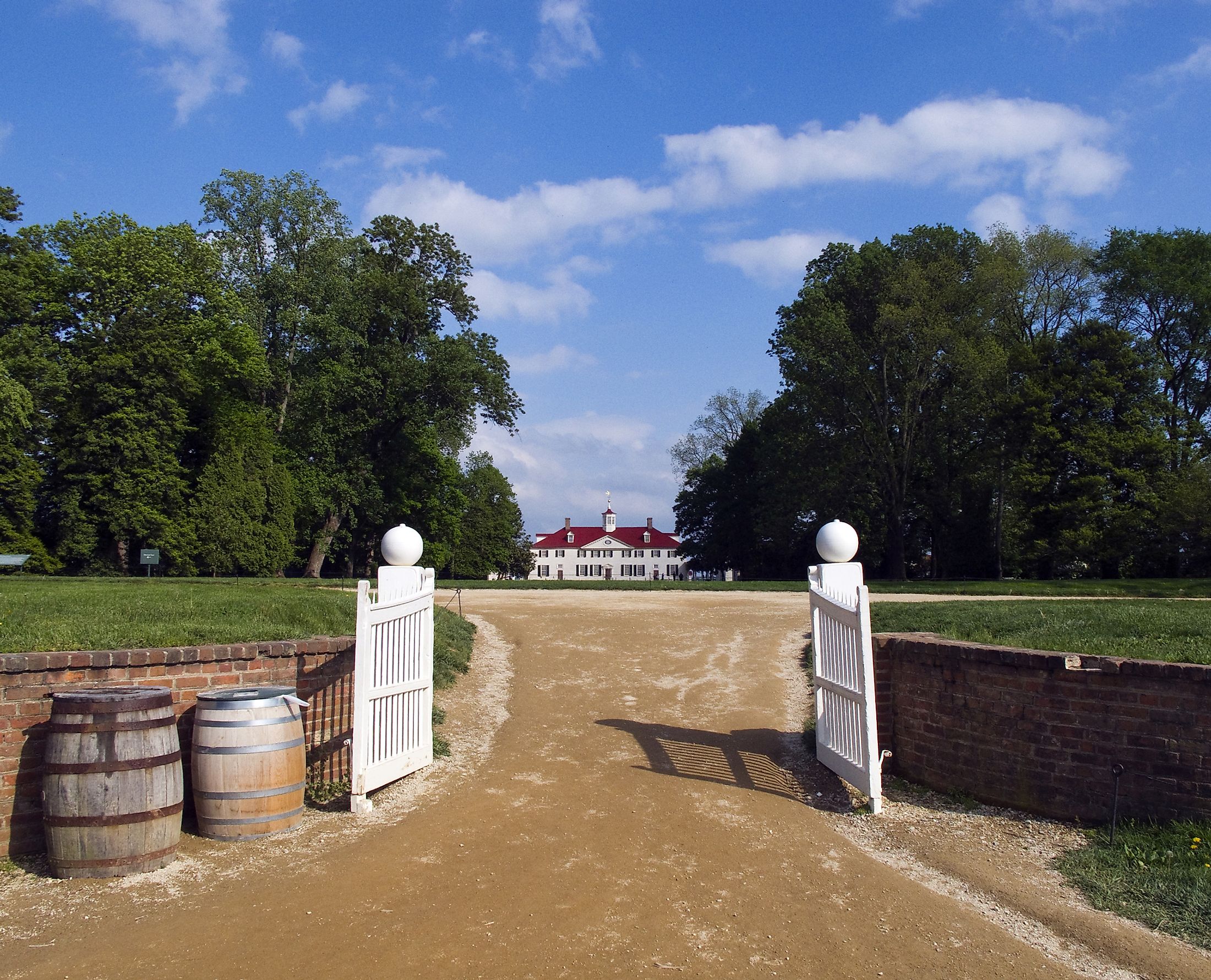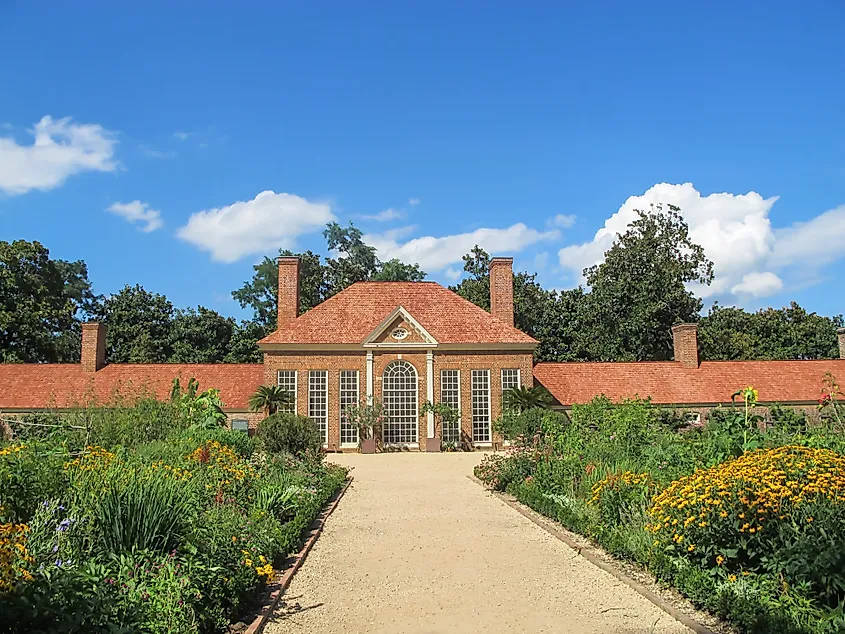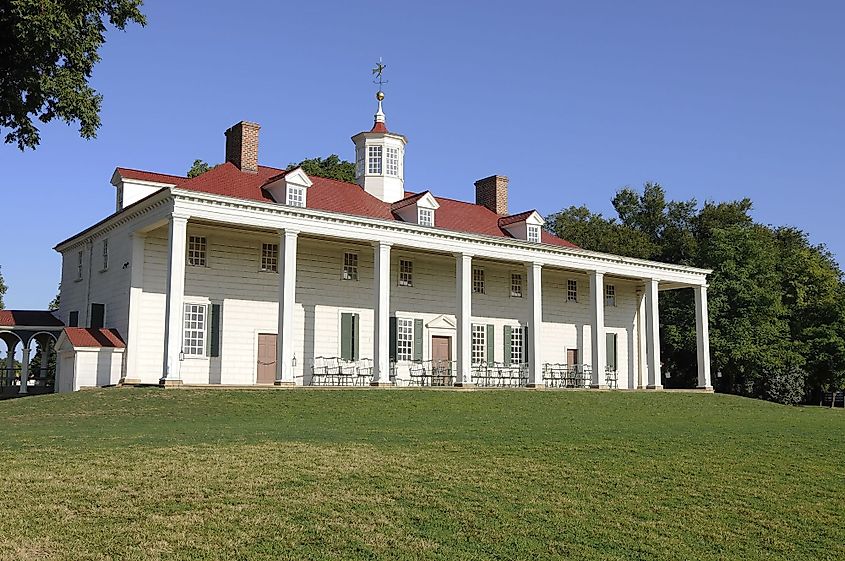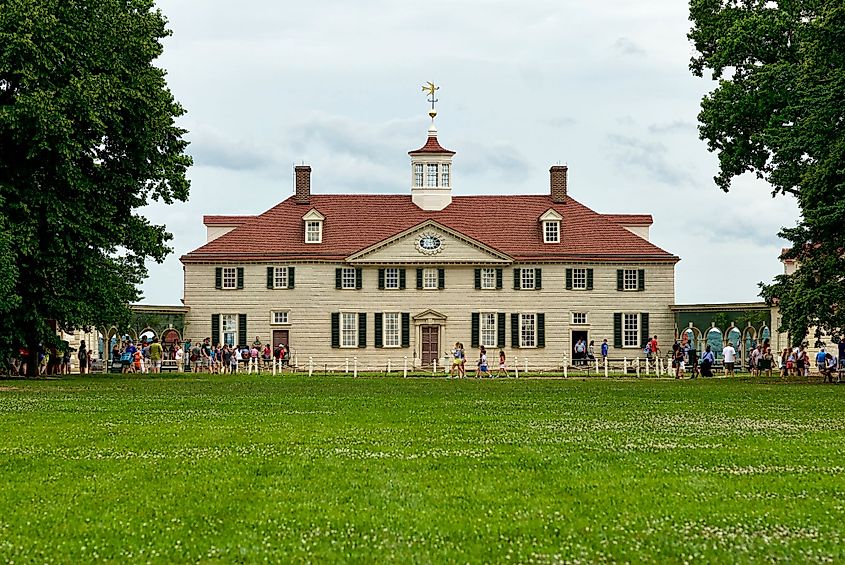
Mount Vernon
Located to the south of Washington D.C, Mount Vernon is the home and former plantation complex of the United States’ first President, George Washington, and his wife Martha. The American landmark is located in Fairfax County of Virginia on the banks of the Potomac River, 13 kilometers south of Old Town Alexandria. The estate also overlooks the river from Prince George’s County, Maryland. Today, George Washington’s former estate is a popular touristic hotspot as it is filled with documents and ephemera belonging to prominent figures in American history. The mansion was built by George Washington’s father Augustine Washington in 1734 and it boasts a unique Palladian style. From Washington’s time in the estate until today, the plantation has been subject to expansions and restoration to preserve its historical importance. Due to its remarkable historical context in American history, Mount Vernon acquired the National Historic Landmark status in 1960 and is listed on the National Register of Historic Places. Today, it is owned by the Mount Vernon Ladies Association. As part of a 200-year-old tradition that George Washington started, the estate is open to the public all year round to enjoy scenic views from the Banks of the Potomac and examine Washington’s carefully curated home.
Brief History

The land became part of the Washington family’s property in 1674 when George Washington’s great grandfather, John Washington, bought the current land of the plantation with his friend, Nicholas Spencer. After John died in 1677, his son Lawrence inherited his father’s shares in the land and divided the estate with the heirs of Nicholas Spencer, who also passed the previous year. The Washingtons’ share was a portion of land along Little Hunting Creek. After Lawrence died in 1698, the property was inherited by his daughter Mildred who agreed to a one-year lease on the estate to her brother Augustine Washington. In 1734, Augustine purchased the land and built a house. From 1735 to 1738, Augustine and his family including young George Washington resided in the Hunting Creek Plantation estate. Augustine’s eldest son and George Washington’s half-brother, Lawrence, was recalled from school and set up for the family’s tobacco plantation on the estate in 1738. In 1740, the estate was deeded to Lawrence, and he renamed the plantation "Mount Vernon" after an English naval officer under whom he had served in the Caribbean. However, George Washington then proceeded to become the sole owner of the estate after the death of his half-brother Lawrence in 1752 and his widow Anne Fairfax in 1761. During George’s time in the estate, the estate was subject to two expansions during 1758 and 1770. Two and a half stories were added to the mansion, followed by rooms at the north and southern ends. The final expansion created the landmark we see today: the plantation was expanded to 8,000 acres with 21 rooms in total instead of 6. Given his interest in agriculture, Washington purchased surrounding parcels of land and added them to the estate during the period from the 1750s through the 1780s. Until the Revolutionary War, five separate farms were added to the estate. When the tobacco market was declining, Washington replaced his crop at Mount Vernon with corn, wheat, and other grains. He also played a major role in permitting Mount Vernon to export fish when he built and operated a small fishing fleet. In 1797, Washington retired from political activities and returned to his home to focus on expanding and improving the plantation.
Fate of Mount Vernon

On December 14, 1799, George Washington died in his home at Mount Vernon. Following his wife’s death, the largest part of the estate which included Mount Vernon was passed to Washington’s nephew, Bushrod Washington. While Bushrod did not inherit a significant amount of cash, proceeds from the estate’s mansion and his Supreme Court salary were insufficient to support the well-being of the estate. Following Bushrod’s death, the estate was passed to Washington’s grandnephew John Augustine Washington II. It then passed to his wife, Jane Charlotte, after his death in 1832. John Augustine Washington III was the final person to inherit the estate after Charlotte’s death, but his funds were scarce, and he couldn’t maintain the mansion and its expenses. While he suggested that Congress purchases the estate, the latter showed little to no interest in that. The Vernon Ladies’ Association, led by Ann Pamela Cunningham, purchased the estate in December 1859, and it was open to the public in 1860 after carrying the first successful nationwide preservation and restoration effort to bring back the 1799 appearance. Several resident superintendents oversaw the estate and even played a role in its rehabilitation, such as Harrison Howell Dodge and Charles Wall. In 1878, steamboats began transporting tourists to Mount Vernon, and an electric railway connecting Alexandria and the estate followed suit in 1892. Up to this date, Mount Vernon is still privately owned by the Mount Vernon’s Ladies’ Association who aims to preserve and manage the estate of George Washington to the highest standards while educating visitors about the late President’s legacy of leadership and sacrifice.
Tourism

While the estate is now a public museum for the public to enjoy, it offers an immersive experience to educate its visitors on George Washington’s legacy and daily life on the plantation. There are several educational and recreational facilities such as the Donald W. Reynolds Museum and Education Center for visitors to observe authentic artifacts. There is also an authentic whiskey distillery, previously one of the largest in the U.S. While visitors can tour the carefully renovated residence, they can also discover the original process of rye whiskey production using authentic distillation techniques. Costumed characters also introduce visitors to the life on the estate during Washington’s time, such as live demonstrations of wheat winnowing and land ploughing. Visitors can also enjoy spectacular vantage points at the banks of the Potomac. One of the small woodlands left on the estate also offers a forest trail that leads visitors to the natural setting of Mount Vernon. As of 2020, the estate has welcomed over 85 million visitors.











